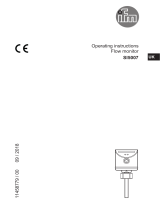
3
UK
8�4 Submenu OUT1 �������������������������������������������������������������������������������������������24
8�5 Submenu OUT2 �������������������������������������������������������������������������������������������26
8�6 Submenu CFG ���������������������������������������������������������������������������������������������28
8�7 Submenus MEM, DIS ����������������������������������������������������������������������������������30
8�8 Submenus COLR, SIM ��������������������������������������������������������������������������������32
9 Set-up ����������������������������������������������������������������������������������������������������������������34
10 Parameter setting ��������������������������������������������������������������������������������������������34
10�1 Parameter setting in general ���������������������������������������������������������������������35
10�1�1 Select submenu �������������������������������������������������������������������������������� 35
10�1�2 Change to the process value display (RUN mode) ��������������������������35
10�1�3 Lock / unlock �������������������������������������������������������������������������������������35
10�1�4 Timeout ��������������������������������������������������������������������������������������������� 36
10�2 Settings for volumetric flow monitoring ������������������������������������������������������ 36
10�2�1 Limit monitoring OUT1 or OUT2 / hysteresis function ����������������������36
10�2�2 Limit monitoring OUT1 or OUT2 / window function ��������������������������36
10�2�3 Analogue signal volumetric flow OUT2 ���������������������������������������������36
10�3 Settings for consumed quantity monitoring �����������������������������������������������37
10�3�1 Quantity monitoring by pulse signal OUT1 or OUT2 ������������������������37
10�3�2 Quantity monitoring by preset counter OUT1 or OUT2 ��������������������37
10�3�3 Manual counter reset ������������������������������������������������������������������������ 37
10�3�4 Time-controlled counter reset �����������������������������������������������������������37
10�3�5 Deactivation of the counter reset ������������������������������������������������������37
10�3�6 Counter reset using an external signal ���������������������������������������������38
10�4 Settings for temperature monitoring ����������������������������������������������������������38
10�4�1 Limit monitoring OUT1 or OUT2 / hysteresis function ����������������������38
10�4�2 Limit monitoring OUT1 or OUT2 / window function ��������������������������38
10�4�3 Analogue signal temperature OUT2 �������������������������������������������������38
10�5 User settings (optional) ������������������������������������������������������������������������������39
10�5�1 Standard display ������������������������������������������������������������������������������� 39
10�5�2 Standard unit of measurement for volumetric flow ���������������������������39
10�5�3 Standard unit of measurement for temperature ��������������������������������39
10�5�4 Measured value damping �����������������������������������������������������������������39
10�5�5 Output logic ��������������������������������������������������������������������������������������40
10�5�6 Low flow cut-off ���������������������������������������������������������������������������������40
10�5�7 Standard conditions �������������������������������������������������������������������������� 40
10�5�8 System pressure �������������������������������������������������������������������������������40
























